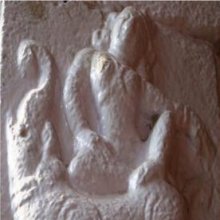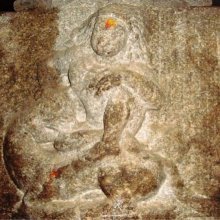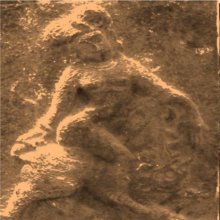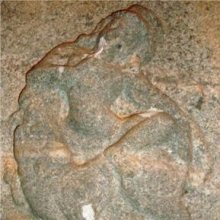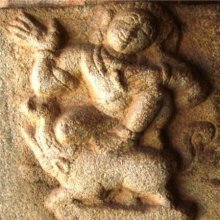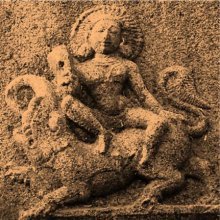Vyali, Vyāli: 7 definitions
Introduction:
Vyali means something in Hinduism, Sanskrit, Marathi. If you want to know the exact meaning, history, etymology or English translation of this term then check out the descriptions on this page. Add your comment or reference to a book if you want to contribute to this summary article.
Images (photo gallery)
(+9 more images available)
In Hinduism
Natyashastra (theatrics and dramaturgy)
Source: archive.org: The mirror of gesture (abhinaya-darpana)One of the Hands that indicate Flying Creatures.—Vyāli, the Vyāli hand, i.e., the forefinger and middle finger bent like a bow, the third finger placed at the base of the thumb, the little finger bent.

Natyashastra (नाट्यशास्त्र, nāṭyaśāstra) refers to both the ancient Indian tradition (shastra) of performing arts, (natya—theatrics, drama, dance, music), as well as the name of a Sanskrit work dealing with these subjects. It also teaches the rules for composing Dramatic plays (nataka), construction and performance of Theater, and Poetic works (kavya).
Shilpashastra (iconography)
Source: DSpace at Pondicherry: Siddha Cult in Tamilnadu (sculpture)Vyāli (व्यालि) or Vyālinātha is one among the Navanāthas. Vyāli’s name has many variants viz., Byāli, Bhāli, Byāri, Bāli, Pāli, Vyādi etc. However, in the book ‘Masters of Mahāmudra’, he is listed last of the ‘Eighty-four Mahāsiddhas’. The work mentions that Vyāli was born in a wealthy Brahmin family, in the land of Apatra. He attempted to prepare a recipe of immortality, but the potion had no effect. Therefore in anger he threw his alchemical manual into the River Ganges, during his 13th year of sādhana.

Shilpashastra (शिल्पशास्त्र, śilpaśāstra) represents the ancient Indian science (shastra) of creative arts (shilpa) such as sculpture, iconography and painting. Closely related to Vastushastra (architecture), they often share the same literature.
Languages of India and abroad
Marathi-English dictionary
Source: DDSA: The Molesworth Marathi and English Dictionaryvyālī (व्याली).—f (Incorrect for vyālēlī participle of viṇēṃ) A female recently delivered. Pr. vyālīcyā vēdanā vyālīsa kaḷēta vāñjhēsa kāya samajē.
Marathi is an Indo-European language having over 70 million native speakers people in (predominantly) Maharashtra India. Marathi, like many other Indo-Aryan languages, evolved from early forms of Prakrit, which itself is a subset of Sanskrit, one of the most ancient languages of the world.
Sanskrit dictionary
Source: Cologne Digital Sanskrit Dictionaries: Cappeller Sanskrit-English DictionaryVyāli (व्यालि).—[masculine] patron. of [several] men.
Source: Cologne Digital Sanskrit Dictionaries: Monier-Williams Sanskrit-English Dictionary1) Vyāli (व्यालि):—a vyāḍi or vyāLi or vyāli m. ([patronymic] [from] vyaḍa [gana] svāgatādi) Name of various men ([especially] of a poet, a grammarian, and a lexicographer), [Ṛgveda-prātiśākhya; Kathāsaritsāgara etc.]
2) a vyāḍi or vyāLi or vyāli m. ([patronymic] [from] vyaḍa [gana] svāgatādi) Name of various men ([especially] of a poet, a grammarian, and a lexicographer), [Ṛgveda-prātiśākhya; Kathāsaritsāgara etc.]
3) Vyālī (व्याली):—[from vyāla] a f. a female snake, [Mahābhārata; Rāmāyaṇa] etc.
4) [from vyāla] b in [compound] for vyāla.
5) Vyāli (व्यालि):—b See vyāḍi.
6) b See vyāḍi, p. 1036, col. 3
[Sanskrit to German]
Sanskrit, also spelled संस्कृतम् (saṃskṛtam), is an ancient language of India commonly seen as the grandmother of the Indo-European language family (even English!). Closely allied with Prakrit and Pali, Sanskrit is more exhaustive in both grammar and terms and has the most extensive collection of literature in the world, greatly surpassing its sister-languages Greek and Latin.
Kannada-English dictionary
Source: Alar: Kannada-English corpusVyāli (ವ್ಯಾಲಿ):—[noun] the plant Argyreia argentea ( = Convolvulus argenteus) of Convolvulaceae family.
--- OR ---
Vyāḷi (ವ್ಯಾಳಿ):—[noun] (myth.) a species of wild animal believed to overpower even lions.
Kannada is a Dravidian language (as opposed to the Indo-European language family) mainly spoken in the southwestern region of India.
See also (Relevant definitions)
Starts with: Vyali Shiksha, Vyalibhu, Vyalibhuta, Vyalidha, Vyalika, Vyalikam, Vyalikanihshvasa, Vyalikata, Vyalikatva, Vyalikh, Vyalikhat, Vyalikita, Vyalimukha, Vyalina, Vyalinatha, Vyalipa, Vyaliy, Vyaliya.
Ends with: Garvavyali.
Full-text (+4): Vyadi, Vyali Shiksha, Vyalibhuta, Khura, Vyadiyaparibhashavritti, Cula, Vyala, Vyadiya, Vyadya, Nyasta, Manjara, Jalandranatha, Vyalinatha, Janani, Hidaga, Vinem, Naganatha, Simhanatha, Kurmanatha, Varahanatha.
Relevant text
Search found 5 books and stories containing Vyali, Vyāli, Vyālī, Vyāḷi; (plurals include: Vyalis, Vyālis, Vyālīs, Vyāḷis). You can also click to the full overview containing English textual excerpts. Below are direct links for the most relevant articles:
Puranic encyclopaedia (by Vettam Mani)
Abhinaya-darpana (English) (by Ananda Coomaraswamy)
Garga Samhita (English) (by Danavir Goswami)
Verse 8.13.85 < [Chapter 13 - A Thousand Names of Lord Balarāma]
Manusmriti with the Commentary of Medhatithi (by Ganganatha Jha)
Verse 3.9 < [Section III - Marriageable Girls]
The Sarva-Darsana-Samgraha (by E. B. Cowell)
